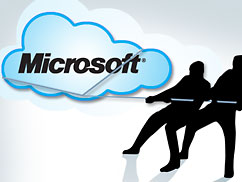Ted Samson| Infoworld
If you’re having a tough time figuring out the Microsoft Cloud OS, you’re not alone. Why else would the company put up a blog post titled “What is the Cloud OS?” the same day it rolls out a host of major upgrades to System Center 2012 and InTune in support of its cloud platform? Microsoft’s basic vision for Cloud OS is for it to function like a desktop or server OS charged with managing hardware and applications — at cloud scale. The company’s dream here is for IT to have a single pane of glass for monitoring and provisioning all the resources running in the company’s private cloud, as well as in partners’ clouds and especially Microsoft’s public cloud, Windows Azure.
For example, an IT admin could flip a couple of switches to transfer a workload from in-house servers to a service provider or to Azure, whether for lack of available hardware on-site, to save money because the service provider can do it more cheaply, or because said IT admin is too short-handed to manage that load himself.
All of that would be completely invisible to end-users, who could go about their workdays, securely accessing apps and data from their device of choice from wherever they happen to have an Internet connection.
This broad vision rests on the combination of Windows Server 2012, Windows Azure, and the linchpin between them, System Center 2012. Available now, Service Pack 1 for System Center 2012 gives companies a means of managing data center components (networking, storage, and compute) as whole, rather than in a piecemeal fashion. The goal is to enable such capabilities as multitenancy, network virtualization, and storage virtualization for automated, hybrid cloud environments.
“All System Center 2012 components are now enabled to run in a Windows Server 2012 environment and provide management capabilities for Windows Server 2012 Hyper-V, Windows Server 2012 Servers, guest operating systems and applications,” according to Mike Schutz, general manager for Windows Server and Management Product Marketing.
System Center 2012 SP1 provides IT with a place for centrally managing cloud-based applications and resources running in their data centers, on a hosted service provider data center, or on Windows Azure. Administrators can, for example, move virtual machines to Windows Azure and manage them from within System Center. They could also use System Center 2012 SP1 to back up their servers to Windows Azure or a third party.
“With SP1, a single instance of Virtual Machine Manager now supports up to 8,000 VMs on clusters of up to 64 hosts, and customers can easily extend beyond these limits with multiple instances of VMM, enabling data center management at large scale,” according to Schutz.
Microsoft also announced it has unified Windows Intune cloud-based service and System Center Configuration Manager as a single management solution for PCs and mobile devices. The marriage aims to provide the tools for securing and managing Windows-based clients (from Windows 8 PCs, Windows RT tablets, and Windows smartphones), as well as devices running Android and iOS.
With Intune, IT admins will now be able “to manage both corporate- and personally owned devices with a single console, making it easier to identify and enforce compliance. Users can also access a self-service portal for selecting and installing company apps,” according to Schutz.
Microsoft is intent on wooing the service-provider market to help build out that broad, interconnecting Cloud OS cluster. To that end, the company announced Windows Azure technologies that providers can run on their own Windows Server 2012 infrastructure “for high-scale website and virtual machine hosting services,” according to the company.
Among Microsoft’s other Cloud OS announcements:
- Configuration Manager 2012 SP1 itself contains several enhancements, including support for Windows 8 and Windows Server 2012, the ability to limit downloads on 3G and 4G network connections to prevent unwanted data charges; native management of Windows Embedded devices, support for PowerShell for administrative tasks, the use of Windows Azure for client package distribution, and support for Mac OS X devices and Linux and Unix servers.
- Endpoint Protection 2012 SP1contains enhancements, including the ability to automatically deploy definition updates three times per day; real-time administrative actions to update definitions, scan, and remediate issues quickly; and client-side merge of antimalware policies.
- The company has rolled out a new Azure-based service called System Center Global Service Monitor that extends System Center’s application monitoring capabilities to help companies evaluate and boost Web-app performance.
- The company has also built an Azure-based management solution called System Center Advisor that enables IT departments to assess server configurations and proactively avoid problems, help to resolve issues faster and reduce downtime, according to Microsoft.













